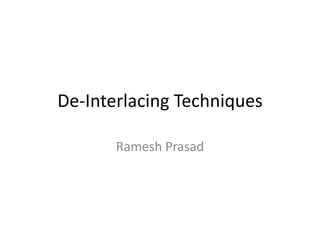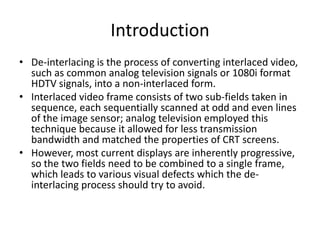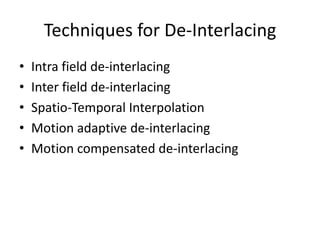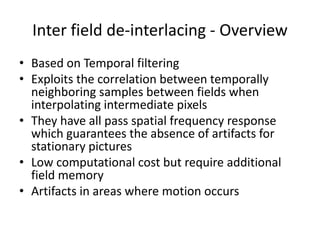De Interlacing Techniques
- 2. IntroductionDe-interlacing is the process of converting interlaced video, such as common analog television signals or 1080i format HDTV signals, into a non-interlaced form.Interlaced video frame consists of two sub-fields taken in sequence, each sequentially scanned at odd and even lines of the image sensor; analog television employed this technique because it allowed for less transmission bandwidth and matched the properties of CRT screens.However, most current displays are inherently progressive, so the two fields need to be combined to a single frame, which leads to various visual defects which the de-interlacing process should try to avoid.
- 4. IntroductionInterlacing is a form of “Spatio-temporal” sub samplingDe-interlacing is the reverse operation, aiming at removal of sub-sampling artifactsFor stationary pictures (no camera or object motion or intensity changes) the de-interlacing is trivial as alternating even and odd fields completely describe the captured sceneHowever, for pictures with camera/object motion and intensity changes (which always is the case with real life scenario); de-interlacing becomes non-trivial and entails processing, as it requires interpolation of picture data that was never transmitted or even captured.A good de-interlacing algorithm should try to avoid interlacing artifacts as much as possible and not sacrifice image quality in the process.
- 5. Introduction
- 6. Techniques for De-InterlacingIntra field de-interlacingInter field de-interlacingSpatio-Temporal InterpolationMotion adaptive de-interlacingMotion compensated de-interlacing
- 7. Intra field de-interlacing - OverviewBased on Spatial filteringExploits the correlation between vertically neighboring samples in a field when interpolating intermediate pixelsThey have all pass temporal frequency response which guarantees the absence of motion artifactsLow computational costLoss of vertical details and artifacts when the object exists in only one parity field
- 8. Intra field de-interlacing – Scan line duplication (Bob)The missing line is generated by duplicating the line directly above itCons-Jagged effect will occur in the oblique line flicker Blur
- 9. Intra field de-interlacing – Scan line duplication (Bob)Jagged EffectFlickerFlicker
- 10. Intra field de-interlacing – Scan line interpolationThe missing line is generated by taking the average of the lines vertically above and below itLess blur, flicker and jagging than scan line duplication method
- 11. Intra field de-interlacing – Edge Line Average (ELA)Interpolation is done in the direction of edgeThree pixels in the previous scan line and the next scan line are referenced to determine the obvious edge in the imageThis method can eliminate the blurring effect of the bilinear interpolation and gives sharp/straight edges.
- 12. Intra field de-interlacing – Edge Line Average (ELA)
- 13. Inter field de-interlacing - OverviewBased on Temporal filteringExploits the correlation between temporally neighboring samples between fields when interpolating intermediate pixelsThey have all pass spatial frequency response which guarantees the absence of artifacts for stationary picturesLow computational cost but require additional field memoryArtifacts in areas where motion occurs
- 14. Inter field de-interlacing – Field Insertion (Weave)The two fields are “woven” into one frame
- 15. It is best solution in case of still images as all vertical frequencies are preserved
- 16. If there is motion between the even and odd fields being woven; artifact called serration or mouse teeth occurs because the moving objects are not shown at the same position for even and odd lines of the single output frameOdd FieldEven Field
- 17. Inter field de-interlacing – Field Insertion (Weave)Difference between Bob and WeaveBobWeave
- 18. Inter field de-interlacing – Field Insertion (Weave)Mouse Teeth Artifact
- 19. Inter field de-interlacing – Temporal AveragingTypes -Mean – Display a half-picture that is created as the average of the two original half-picturesThe Mean algorithm simply pairs the original lines, and averages each pair into one output line. Line 1 of output is the mean of lines 1 and 2 in input, line 2 of output is the mean of lines 3 and 4 in input, and so on.Blend – Each line of the picture is created as the average of a line from the odd and a line from the even half-pictures. This ignores the fact that they are supposed to be displayed at different times The first line of output is copied from the first line of input. For any other output line N, the line is the mean of input lines N and N-1. That is, the second line of output is the mean of lines 1 and 2 in input, the third line is the mean of lines 2 and 3, ... and finally, the last line of output is the mean of the last two lines in input. The sliding averaging procedure preserves the original vertical resolution.Pros – Mouse Teeth artifact is avoidedCons – Artifact called ghosting is introduced
- 20. Inter field de-interlacing – Temporal AveragingGhosting Artifact
- 21. Spatio-Temporal Interpolation - OverviewBased on Spatio-Temporal filteringExploits the correlation between both spatially and temporally neighboring samples when interpolating intermediate pixelsThe filter is usually designed such that the contribution from the neighboring fields is limited to the higher vertical frequenciesHence, motion artifacts are absent for objects without vertical details that move horizontallyThe vertical detail from the previous field is being combined with the temporally shifted current field, so some motion artifacts may occur.
- 23. Motion adaptive de-interlacing - OverviewIt combines the advantages of both intra-field and inter-field interlacingIt detects the motion first, and then adopts intra field de-interlacing in motion areas and inter-field de-interlacing in static areasHigh resolution and flicker free picture can be realized in motion and static areaIt relies on accurate motion detection; erroneous detection cause artifacts
- 25. Motion adaptive de-interlacingThe motion detection block detects the motion between the two fieldsThe output of the motion detection block controls the selector switch for the intra or inter interpolated valuesFor moving image parts, intra interpolated values are passed and for static image parts inter interpolated values are passedFinally an interleaving switch interleaves the current field and the interpolated sample to form the progressive frameThe intra and inter interpolation mechanism could be any of the techniques described earlier
- 26. Motion adaptive de-interlacingInstead of a switch, a fade mechanism could be used which combines the intra and inter interpolated samplesFst is the result of interpolation for static image parts
- 27. Fmot is the result of interpolation for moving image parts
- 28. Motion detector determines the mix factor “alpha” with “alpha” = 0 for very high motion and “alpha” = 1 in absence of motionMotion adaptive de-interlacing – Motion DetectionSame-parity-field detectionFor interlaced video, the vertical position of even field and odd field is slightly differentSame-parity-field detection detects the motion area by the even-field to even-field or odd-field to odd-field difference
- 29. Motion adaptive de-interlacing – Motion Detection
- 30. Motion adaptive de-interlacing – Motion Detection4-Field motion detectionTo improve the accuracy of motion detection, 4 fields rather than 2 fields are usedThe fields are labeled backward, current, forward and forward-forwardThe differences are computed for fields of same parity; backward-forward and current-forward-forward
- 31. Motion adaptive de-interlacing – Motion Detection
- 32. Motion adaptive de-interlacing – Motion Detection
- 33. Motion adaptive de-interlacing – Implicit Adaptation (Median Filtering)Median Filtering adapts implicitly to motionThe simplest version is a 3-tap spatio-temporal filter which uses the immediate vertical up, down and temporal neighbor in the previous fieldThe underlying assumption is that in case of stationarity, the temporal neighbor is likely to have a value between that of the vertical neighbors of the current field In case of motion, intra-field interpolation is likely to result, since the correlation between the samples in the current field is likely to be highestHence Median filtering automatically realizes the intra/inter switchPros: Superior properties at vertical edges and low hardware costCons: Distortion of vertical details and introduction of alias
- 34. Motion adaptive de-interlacing – Implicit Adaptation (Median Filtering)
- 35. Motion compensated de-interlacing - OverviewIt’s the most advanced technique for interpolationMotion compensated method try to interpolate in the direction with highest correlation; with motion vector available, this is the interpolation along the motion trajectoryIt allows the moving sequences to be converted virtually into stationary ones and use methods which work well on stationary sequences like line insertion etc.Motion compensated methods needs to be combined with scene change detection, otherwise it will attempt to find motion between two completely different scenesUsually a combination of Edge directed spatial interpolation and motion compensated temporal interpolation is used in practiceIt outperforms other techniques in terms of quality of the de-interlaced frameIt’s the most complex and processing intensive technique as it involves motion estimation
- 37. Motion compensated de-interlacingMotion estimation is performed on the fields of same parity (backward and forward fields) as they have the same sampling gridHalf pel/quarter pel accuracy can be used for motion estimationAs the backward and forward fields are of different parity than the current field, the blocks need to be shifted to the sampling grid of the current fieldTo obtain the position of the block in the current interpolated field from the previous field, the motion vectors are halved and the blocks of backward, current and forward field moved simultaneously to the sampling grid of the current interpolated field
- 38. Motion compensated de-interlacingBlock shifting to match the sampling gridPixel value in the current interpolated field
- 39. Motion compensated de-interlacingTo handle scene change detection, the pixel values obtained by motion compensated interpolation are compared with the spatial edge directed interpolated pixel valuesIf the difference is beyond the threshold value, its assumed that interpolation based on motion estimation is incorrectIn such case, directional interpolation is used instead of motion compensated interpolationThe motion compensated/edge directed interpolated pixels are finally combined to get the progressive frame
- 40. ReferencesAltera White Paper - High-Definition Video Deinterlacing Using FPGAsDeinterlacing - An OverviewGERARD DE HAAN, ERWIN B. BELLERSDeinterlacing using directional interpolation and motion compensationOhjae Kwon, KwanghoonSohn, Chulhee LeeMotion Adaptive Interpolation with Horizontal Motion Detection for DeinterlacingShyh-Feng Lin, Yu-Ling Chang, and Liang-Gee Chen
- 41. Thank You






































